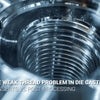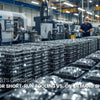What Are The Essential Design Principles For Successful Sheet Metal Fabrication in 2025?

What Are The Essential Design Principles For Successful Sheet Metal Fabrication in 2025?

In today's rapidly evolving manufacturing landscape, mastering sheet metal fabrication has become increasingly crucial for businesses seeking to maintain their competitive edge. As we navigate through 2025, understanding the fundamental principles of sheet metal design and fabrication can significantly impact your project's success, cost-effectiveness, and overall quality.
This comprehensive guide delves into the essential aspects of sheet metal fabrication, from material selection to advanced techniques, helping you make informed decisions for your manufacturing projects.
Whether you're an engineer, designer, or project manager, this guide will equip you with the knowledge needed to optimize your sheet metal fabrication processes and achieve superior results.
[Table Of Content]
- What Are The Fundamental Types of Sheet Metal Materials You Should Know?
- How Do Design Principles Impact Your Sheet Metal Fabrication Success?
- Which Sheet Metal Fabrication Techniques Are Most Effective Today?
- How To Choose The Right Material For Your Sheet Metal Project?
- Why Are Tolerances and Surface Finishes Critical in Sheet Metal Design?
What Are The Fundamental Types of Sheet Metal Materials You Should Know?
The foundation of any successful sheet metal project lies in understanding the diverse range of available materials. Each material type offers unique properties that can significantly impact your final product's performance and cost-effectiveness.
Common materials in modern sheet metal fabrication include aluminum, steel, stainless steel, and copper. Each material presents distinct advantages and challenges that must be carefully considered during the design phase.

When selecting materials for your project, consider factors such as:
- Material strength and durability requirements
- Environmental exposure conditions
- Cost constraints and budget considerations
- Weight limitations
- Aesthetic requirements
How Do Design Principles Impact Your Sheet Metal Fabrication Success?
Understanding and implementing proper design principles is crucial for achieving optimal results in industrial machinery and components. These principles serve as the foundation for creating parts that are both functional and manufacturable.
Effective sheet metal design requires careful attention to several key factors, including bend radii, material thickness, and overall part geometry. Following these principles helps ensure your parts can be manufactured efficiently and cost-effectively.
To optimize your designs, consider:
- Minimum bend radius requirements
- Material thickness variations
- Tool accessibility
- Assembly requirements
- Cost optimization strategies
Which Sheet Metal Fabrication Techniques Are Most Effective Today?
Manufacturing excellence in sheet metal fabrication relies heavily on selecting the right techniques for your specific application. Modern fabrication methods have evolved significantly with technological advancement, offering greater precision and efficiency.
Understanding these cutting-edge techniques can dramatically impact your project's success rate and help optimize both quality and cost-effectiveness. Let's explore the most effective methods used in today's sheet metal fabrication industry.

Here's a comprehensive breakdown of today's most effective techniques:
- Cutting Technologies:
- Laser Cutting: Offers precision up to ±0.1mm and clean edges
- Plasma Cutting: Ideal for thick materials up to 160mm
- Water Jet Cutting: Perfect for heat-sensitive materials
- CNC Punching: Cost-effective for high-volume production
- Forming Methods:
- Press Brake Forming: Achieves bends up to 90 degrees with high accuracy
- Roll Forming: Suitable for long, continuous profiles
- Stamping: Efficient for high-volume parts
- Deep Drawing: Creates complex three-dimensional shapes
- Joining Techniques:
- MIG/MAG Welding: Versatile for most materials
- TIG Welding: Provides high-quality, precise joins
- Spot Welding: Ideal for overlapping joints
- Mechanical Fastening: Used when welding isn't suitable
How To Choose The Right Material For Your Sheet Metal Project?
Material selection forms the cornerstone of successful sheet metal fabrication. The right choice can mean the difference between project success and costly failures. This decision requires careful consideration of multiple factors.
Modern manufacturing demands increasingly specialized materials to meet specific performance requirements. Let's explore the systematic approach to selecting the optimal material for your project.
Essential factors to consider in material selection:
- Performance Requirements:
- Mechanical Properties:
- Tensile strength (ranges from 30,000 to 100,000 PSI)
- Yield strength
- Hardness ratings
- Environmental Resistance:
- Corrosion resistance
- Temperature tolerance
- Chemical resistance
- Mechanical Properties:
- Manufacturing Considerations:
- Formability (minimum bend radius)
- Weldability
- Machinability rating
- Surface finish capabilities
- Economic Factors:
- Raw material costs
- Processing requirements
- Production volume
- Lifecycle costs
- Material-Specific Characteristics:
- Aluminum: Light weight, excellent corrosion resistance
- Steel: High strength, cost-effective
- Stainless Steel: Superior corrosion resistance
- Copper: Excellent conductivity
- Titanium: High strength-to-weight ratio
Why Are Tolerances and Surface Finishes Critical in Sheet Metal Design?
Tolerances and surface finish specifications play a crucial role in determining both the functionality and manufacturability of sheet metal parts. These specifications directly impact assembly fit, aesthetic appearance, and overall product performance.
Proper understanding and specification of tolerances and surface finishes can significantly reduce manufacturing costs while ensuring that parts meet all functional requirements. This knowledge is essential for creating efficient and cost-effective designs.
Critical aspects of tolerances and surface finishes:
- Tolerance Considerations:
- Standard Tolerances:
- ±0.005" for critical dimensions
- ±0.010" for non-critical dimensions
- ±0.020" for formed features
- Geometric Tolerances:
- Flatness: 0.5mm per 300mm typical
- Perpendicularity: 0.5° maximum
- Position: ±0.13mm for critical features
- Standard Tolerances:
- Surface Finish Specifications:
- Common Finish Types:
- Mill finish: 80-120 RMS
- Brushed: 20-50 RMS
- Polished: 10-20 RMS
- Mirror: <10 RMS
- Common Finish Types:
- Impact on Manufacturing:
- Tighter tolerances increase costs
- Surface finish affects:
- Tool wear
- Processing time
- Material handling requirements
- Final product cost
- Quality Control Methods:
- CMM measurement for tolerances
- Surface roughness testers
- Visual inspection standards
- Documentation requirements
Conclusion
Success in sheet metal fabrication requires a thorough understanding of materials, design principles, and manufacturing techniques. By carefully considering each aspect covered in this guide, you can optimize your designs for both functionality and manufacturability.
Remember that successful sheet metal fabrication is an iterative process that often requires balancing various factors to achieve optimal results. Stay informed about industry trends and continue to refine your approach based on experience and new technologies.
[External Links Recommendation]
-
Posted in
CNC machining, Sheet Metal Fabrication





